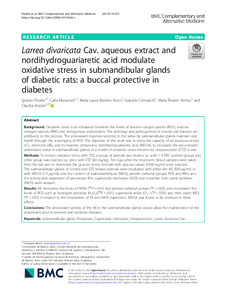Por favor, use este identificador para citar o enlazar este ítem:
https://repositorio.uca.edu.ar/handle/123456789/9301| Título: | Larrea divaricata Cav. aqueous extract and nordihydroguariaretic acid modulate oxidative stress in submandibular glands of diabetic rats : a buccal protective in diabetes | Autor: | Peralta, Ignacio Marrassini, Carla Barreiro Arcos, María Laura Cremaschi, Graciela A. Anesini, Claudia |
Palabras clave: | ESTRES OXIDATIVO; ANTIOXIDANTES; ESTOMATOLOGIA; GLANDULAS SALIVALES; ENZIMAS; SALUD BUCAL; DIABETES | Fecha de publicación: | 2019 | Editorial: | BMC | Cita: | Peralta, I., et al. Larrea divaricata Cav. aqueous extract and nordihydroguariaretic acid modulate oxidative stress in submandibular glands of diabetic rats: a buccal protective in diabetes [en línea]. BMC Complementary and Alternative Medicine. 2019, (19)227. doi: 10.1186/s12906-019-2636-z. Disponible en:https://repositorio.uca.edu.ar/handle/123456789/9301 | Resumen: | Abstract: Background. Oxidative stress is an imbalance between the levels of reactive oxygen species (ROS), reactive nitrogen species (RNS) and endogenous antioxidants. The aetiology and pathogenesis of several oral diseases are attributed to this process. The antioxidant enzymes secreted in the saliva by submandibular glands maintain oral health through the scavenging of ROS. The objective of this work was to study the capacity of an aqueous extract of L. divaricata (AE), and its majority compound, nordihydroguariaretic acid (NDGA), to modulate the pro-oxidant/antioxidant status in submandibular glands in a model of oxidative stress induced by streptozotocin (STZ) in rats. Methods. To induce oxidative stress with STZ, a group of animals was treated i.p. with 1 X PBS (control group) and other group was injected i.p. once with STZ (60 mg/kg). Ten days after the treatment, blood samples were taken from the tail vain to determine the glucose levels. Animals with glucose values ≥300 mg/ml were selected. The submandibular glands of control and STZ treated animals were incubated with either the AE (500 μg/ml) or with NDGA (1.5 μg/ml), and the content of malondialdehyde (MDA), protein carbonyl groups, ROS and RNS, and the activity and expression of peroxidase (Px), superoxide dismutase (SOD) and inducible nitric oxide synthase (iNOS) were assayed. Results AE decreased the levels of MDA (P < 0.01) and protein carbonyl groups (P < 0.05), and modulated the levels of ROS such as hydrogen peroxide (H2O2)(P < 0.01), superoxide anion (O2.-) (P < 0.05) and nitric oxide (NO) (P < 0.05) in relation to the modulation of Px and iNOS expression. NDGA was found to be involved in these effects. Conclusions. The antioxidant activity of the AE in the submandibular glands would allow the maintenance of the antioxidant pool to prevent oral oxidative diseases. | URI: | https://repositorio.uca.edu.ar/handle/123456789/9301 | ISSN: | 1472-6882 (en línea) | Disciplina: | MEDICINA | DOI: | 10.1186/s12906-019-2636-z | Derechos: | Acceso abierto | Fuente: | BMC Complementary and Alternative Medicine. 2019, (19)227 |
| Aparece en las colecciones: | Artículos |
Ficheros en este ítem:
| Fichero | Descripción | Tamaño | Formato | |
|---|---|---|---|---|
| larrea-divaricata-cav-aqueous-extract.pdf | 2,37 MB | Adobe PDF |  Visualizar/Abrir |
Visualizaciones de página(s)
395
comprobado en 22-dic-2025
Descarga(s)
221
comprobado en 22-dic-2025
Google ScholarTM
Ver en Google Scholar
Altmetric
Altmetric
Este ítem está sujeto a una Licencia Creative Commons

